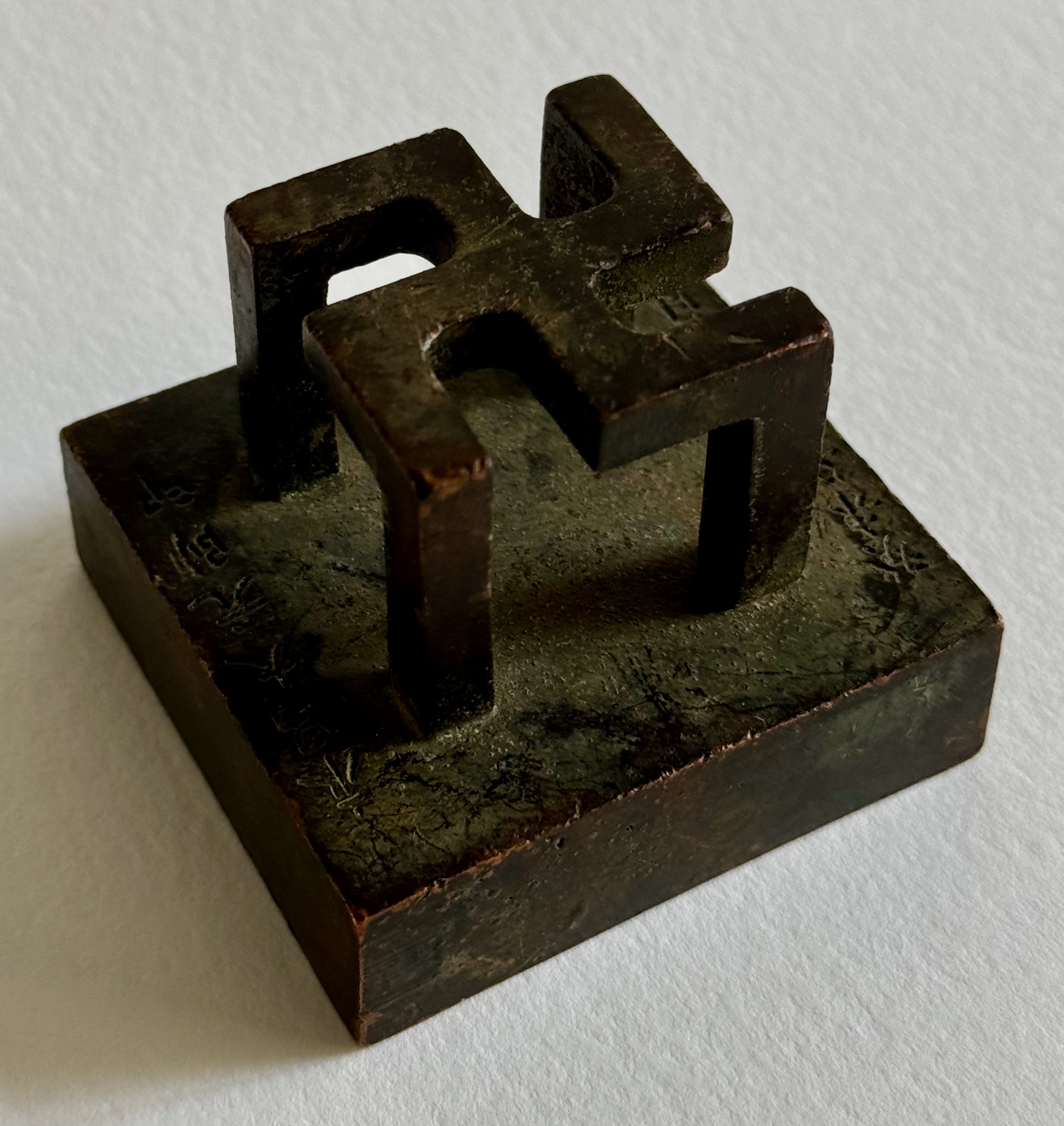

Title: Large Antique Chinese Signature bronze Stamp Seal Chop Tool Swastika
Shipping: $29.00
Artist: N/A
Period: 19th Century
History: Art
Origin: Central Asia > China
Condition: Excellent
Item Date: N/A
Item ID: 659
This is a spectacular Large Antique Chinese Signature bronze Stamp Seal Chop Tool Swastika. These seals were used by emperors, government officials, and private individuals to authenticate documents, deeds, and other official papers. The swastika's introduction to China is largely associated with the arrival of Buddhism from India around the 1st century CE. In Buddhism, the swastika symbolizes the footprint of the Buddha and represents eternity, the cycle of life, and the infinite nature of Buddha's teachings. It can be found in Buddhist art, scriptures, and temples across China. The symbol itself predates Buddhism, having roots in ancient Indian cultures where it represented good fortune and auspiciousness. When Buddhism spread to China, the swastika was adopted and became an integral part of Chinese Buddhist iconography. The symbol is often depicted on statues of the Buddha, especially on his chest or palms, symbolizing his eternal power and the universal nature of his teachings. In China, the swastika can appear in two forms: clockwise (卍) and counterclockwise (卐). While the clockwise version is the more commonly seen form, both are considered auspicious in Chinese culture. The symbol is associated with longevity, prosperity, and harmony, embodying the concept of "ten thousand things" or the totality of existence. / Bronze seals, however, became more popular during the Zhou Dynasty (1046–256 BCE) and reached their peak in the Han Dynasty (206 BCE–220 CE). The size 2 1/4 inch square. The height is 2 inches tall. I have not been able to interpret the signature. During the Ming (1368–1644) and Qing Dynasties (1644–1912), the use of bronze seals became widespread. The styles became more sophisticated, with intricate designs and high-quality craftsmanship. Seals were often passed down through generations, becoming family heirlooms. Antique Chinese bronze seals have become valuable collector's items due to their historical and cultural significance. Collectors often look for seals that have clear and well-preserved inscriptions, intricate carvings, and a rich patina that develops over time. Many bronze seals are also valued for their aesthetic qualities, particularly those with mythological creatures or intricate designs on the handle. The chop seals were usually pressed into a red ink paste made from cinnabar and other ingredients, creating a vivid and long-lasting mark. This practice continues today, and the red seal marks can be seen on Chinese paintings, calligraphy, and documents. Official Seals: In ancient China, officials and scholars were required to use seals to approve government decrees, orders, and legal documents. These official seals symbolized authority and were often elaborately designed to denote the status of the individual or the institution. During these early dynasties, seals were considered a mark of authority, with only the emperor and high-ranking officials permitted to use certain types. Each official had their own unique seal, and the emperor's seal, known as the "Imperial Seal," was seen as a symbol of divine authority. The use of seals in China dates back to the Shang Dynasty (c. 1600–1046 BCE), where they were primarily made from jade, gold, or stone. Antique Chinese bronze signature stamp seals, often referred to as "chop seals," have a long and culturally significant history in China. They were used as personal signatures or official seals and played an essential role in Chinese identity and communication for centuries. The term "chop" originated from the Hindi word "chhapa," meaning "stamp," and was adopted during interactions between Chinese merchants and traders from the West. Antique Chinese bronze chop seals are a unique and significant part of Chinese history, culture, and art. Their use, which spans over two millennia, reflects the importance of written communication, authority, and personal identity in Chinese society. Today, they remain prized artifacts, both for their functional history and their artistic craftsmanship.
Antique Chinese bronze chop seals are a unique and significant part of Chinese history, culture, and art. Their use, which spans over two millennia, reflects the importance of written communication, authority, and personal identity in Chinese society. Today, they remain prized artifacts, both for their functional history and their artistic craftsmanship. The swastika has a long and complex history in Chinese culture, symbolizing auspiciousness, eternity, and well-being. It is one of the oldest symbols in human history, and in China, it is known as "wàn" (卍), which translates to "ten thousand" or "all-encompassing." Its origins in China are deeply intertwined with religious and cultural contexts, particularly in Buddhism, but it has also been used in other aspects of Chinese culture. In the context of Daoism and traditional Chinese philosophy, the swastika was sometimes used as a symbol of the universe’s balance and harmony. The symbol itself is thought to represent the interconnectivity of all things and the flow of positive energy through the cosmos. In addition to religious and decorative uses, the swastika has been used to represent the number 10,000, which in Chinese culture signifies infinity or eternity. This is why it is often paired with phrases like "ten thousand years of peace" or "long life without end. In China and much of Asia, however, the swastika largely retains its original positive connotations. It is still found on temples, religious iconography, and works of art, representing peace, protection, and auspiciousness, as it has for thousands of years. The swastika in Chinese culture is a powerful symbol that embodies positive ideals of good fortune, eternity, and universal harmony. Its history in China is deeply linked to the spread of Buddhism and its integration into various aspects of Chinese art, religion, and philosophy. Despite modern associations in the West, the Chinese swastika remains an enduring emblem of auspiciousness and spiritual balance.